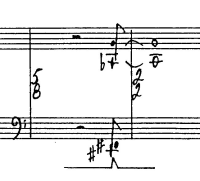I’ve taken a break from Palais de mari for awhile, but am playing it again more and starting to think about how this piece works: how does Feldman make the continuity? To me, this is one of the central questions about Feldman’s work, especially the later pieces. I’ve thought about this in the past but never had a good place to start. With Palais de mari, I’m using my performance as the starting point. As I said in my last post, I’m feeling my way through the music when I play, and this seems like an ideal way to start understanding Feldman.
Let me begin with something very basic: the articulation of events within the piece. As you play any piece, you become very aware of points of articulation, places where one thing ends and another begins. It seems sort of obvious to state this. Feldman, however, provides none of the usual cues for this in the score, so there’s a challenge here. There are no phrase markings, no changing tempi, no special pauses, and no double bar lines. There are no expressive markings, no indications of touch (staccato, legato), no accents, and essentially no dynamic markings at all (just ppp at the start and diminuendi hairpins applied to a specific pair of chords that appear three times in the piece). The music is pretty much a bunch of notes blankly staring back at you from the page, the only points of interest being some grace notes and a handful of pedal markings (a special feature I’ll discuss further below).
Another obvious articulating factor is the pedaling. The pedal is marked to be depressed at the start of the piece, and that’s where it stays for the vast majority of it. This means that everything is resonating all the time, the decays occurring naturally and gradually. At eight different points, however, Feldman indicates that the pedal should be shifted, released and then immediately depressed again. This cuts the accumulated resonance off abruptly at those points. All six of these places are associated with the same kind of chord, with the left hand part of the chord short, contributing only to the attack, and the right hand held longer:
The main way that I discover a point of articulation is by hearing a change in the musical imagery and associated mood. The opening of the piece, for example, is bright and open through the first 30 measures or so. The music is dominated by two-note phrases in a lilting 5/8 rhythm of threes and twos. At measure 33 the imagery changes completely: longer, thicker, darker chords in the middle register, all downbeat (no lilt) with high grace-note accompaniments. It’s a totally different mood, a change in direction of thought. I usually use the una corda here as a way of further setting this off as a different world.
Much of the piece is this alternation between the light and dark, open and closed music in one form or another. The lilting two-note phrases acquire grace-note adornments as the piece progresses, but you still have the feeling of that same light, open, sweet mood. The “breathing” music I wrote about earlier is part of the dark world, and as I noted there, it interrupts the lighter world of the grace-note phrases. Moving between the two worlds is the source of much of the lifeline of this piece, what generates the sense of continuity we experience.
This is not to suggest that these worlds exist in large blocks jammed up against each other, although that might be suggested by my example from the first page. In some places different kinds of imagery appear in rapid succession, and this has the effect for me of confusion, of not knowing where to settle. The first part of page 3 is a great example. Here in the space of 20 bars Feldman juxtaposes dark and light rapidly, sometimes measure by measure, and tries out a few new pitch combinations. It ends with a series of five disconnected chords all in a row in a manner that occurs nowhere else in the piece—another “reset button” moment. The whole thing gives me the strong impression that he’s searching for something and not finding it. Not that Feldman was deficient in these passages, not that his concentration and craft as a composer was failing. Instead, it is more that the effect he is after is one of uncertainty, a blur, a vacillation, followed by an erasing of what happened before starting over. When I play that passage, I keep that in mind and try to play in a way that will give that effect, including a bit of a fermata at the end. Here’s my rendition:
[wpaudio url=”http://www.rosewhitemusic.com/audio/PalaisExamplePage3.mp3″ text=”Morton Feldman: Palais de mari, excerpt (2011, James Pritchett)” dl=”0″]
This starts to get at what I’ve intuited about Feldman for some time, but never really approached analytically: that his music has the character of thought, of mind. The way things happen in a Feldman piece is similar to the way our thoughts move: now dwelling upon this, now that, now confused. I’ll have another post soon about these trains of thought in Feldman.

